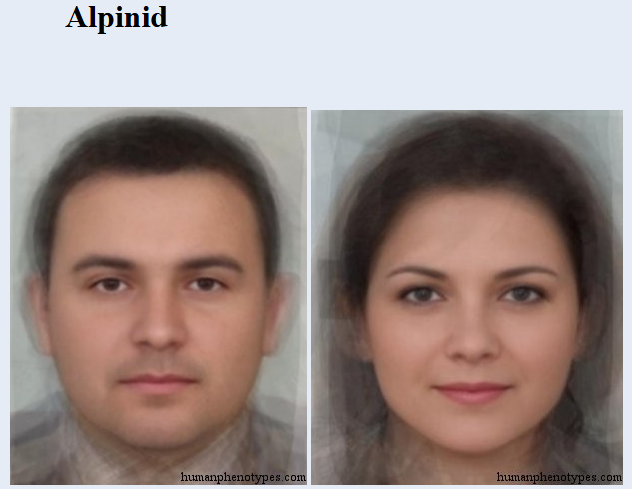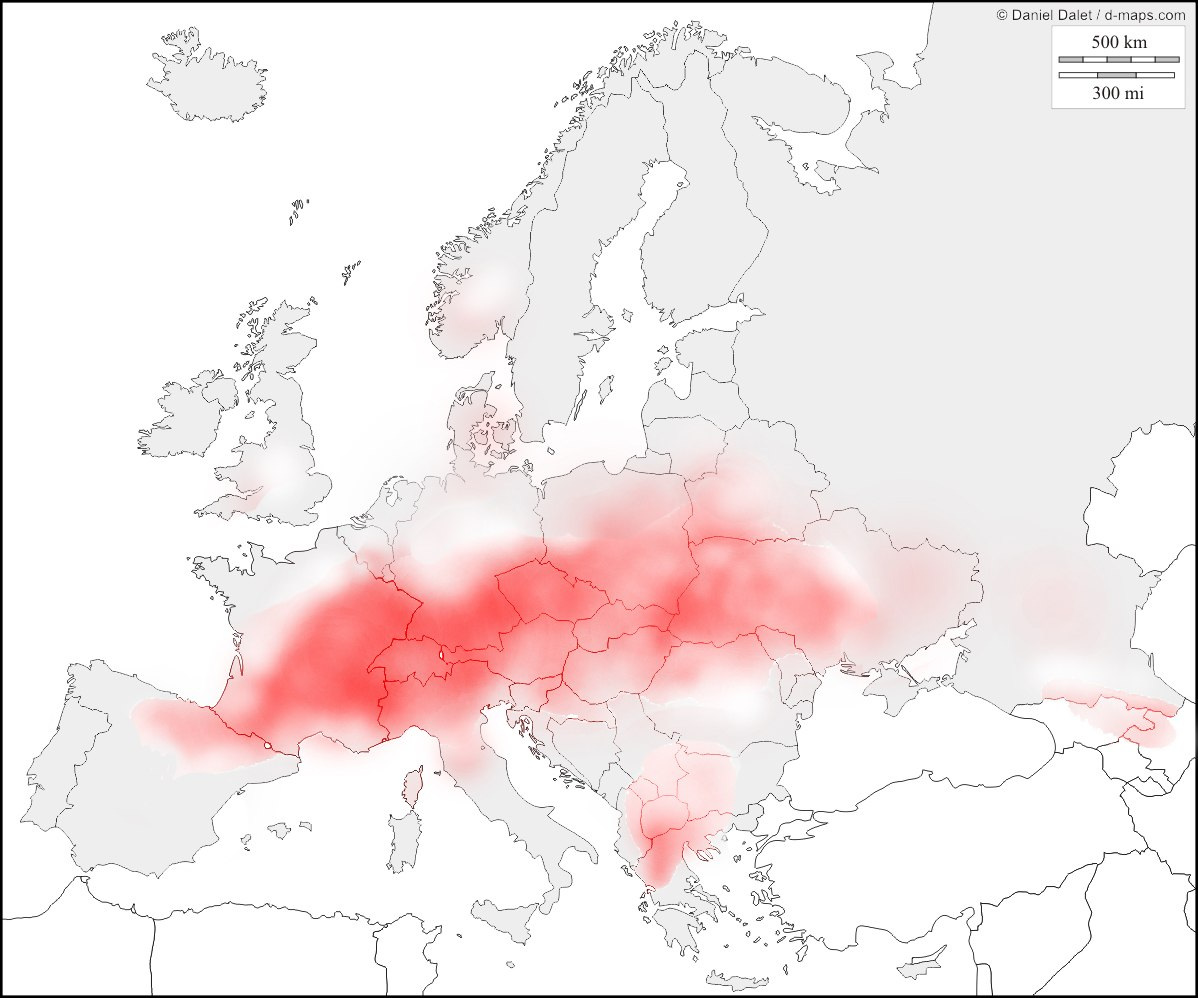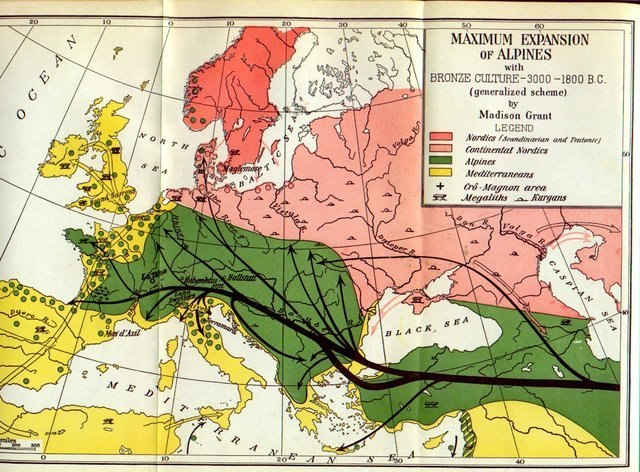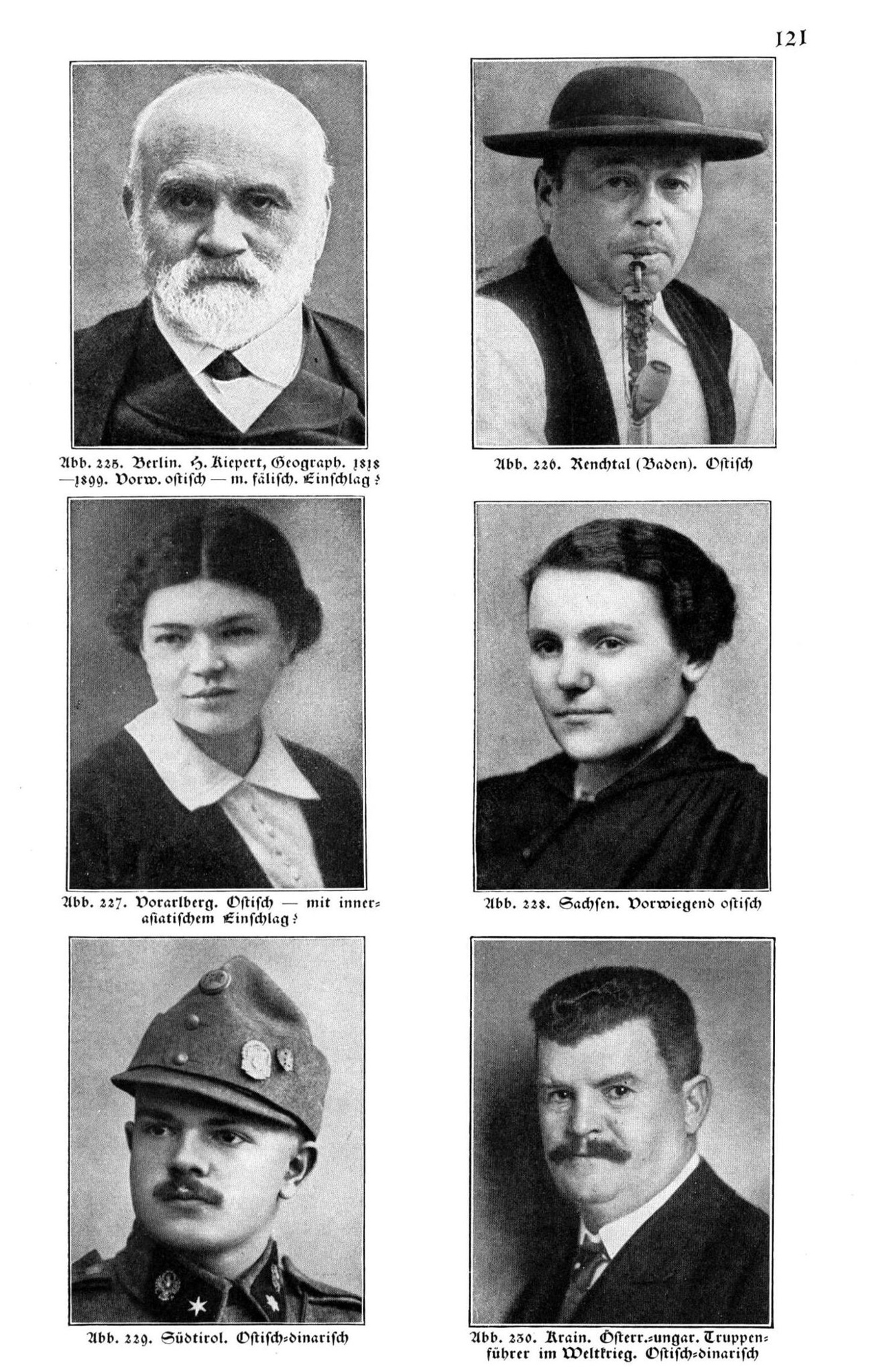L
LooksmaxxMyAss
Charismamaxxing is law
- Joined
- Apr 19, 2025
- Posts
- 3,775
- Reputation
- 5,146
Alpinids can be easily distinguished by their round face: they have a small, unmarked chin, and their cheekbones are the widest part of their face. Their skull is brachycephalic, wide, and appears spherical, with a rounded back. The brachycephaly of the Alpinid is expressed due to the large width of the skull + the non-protruding nape (whereas in the Eastern Baltic it is only due to the large width, the nape is usually weakly but expressed).
The facial features are smoothed, the appearance is "southern" (in the Eastern Baltic, the facial features are angular and, unlike the Alpinid, there are lappoid features). Hair and eyes are dark.



G. Günther in his work "Rassology of the German People" describes the Alpinids as follows:"Features: short stature, short head, broad face with an underdeveloped chin; short, snub nose with a flat base; stiff brown or black hair; bulging, brown eyes; yellowish-brown skin. In Deniker, this race is called the Western or Sevennian race, and Ripley, following Lapouge, calls it the Alpine race. Broca uses the term "Celtic type," and some French and Italian researchers refer to it as the "Celto-Slavic" type. Von Hölder calls it the "Turanian" type, Beddow calls it the "Overnian" type, and Sergi calls it the "Eurasian" type. Virchow identified the "South German brachycephalic" type, and Recius identified the "orthognathic brachycephalic" type; today, this race is often referred to as the "Mongoloid" and "Turanian" races, and the term "Homo alpinus" is often used in Latin nomenclature. Recius also called this race Slavic-Rhetian, while Wilser called it simply round-headed. Mydlarski's type w shares similarities with the Eastern race. I chose the name "Eastern" because it indicates a connection with Asia, but not in the sense of classifying this race as Mongoloid. In my opinion, the name "Alpine" leads to a false conclusion, as people of this race are only found in the Alps, which is mostly a region of mixed Dinaric and Eastern types."
In B. Lundman's work, the East European alpinids were referred to as the Gorids. This racial type is widely distributed near the Carpathian Mountains, particularly in southern Poland and western and central Ukraine.
For K. Kun, the origin of the alpinids remained a mystery, but he noted that they were influenced by several racial elements, including a round-headed element and a possible Mediterranean element.
Kun described the outskirts of the Alpine race's distribution area as follows:
"Based on the available published data, it is impossible to determine how far eastward the Alpine manifestation zone extends beyond Russian Turkistan. If it extends beyond the Tian Shan, it has been so altered by intermixture with Mongoloids that its identification would be challenging. The Tajiks represent the last outpost in the vast Alpine preservation or manifestation zone, which extends eastward from France with minor interruptions for nearly 5,000 miles. Like their French counterparts, they are more Alpine and less Mediterranean than most people in the middle."
"The width of the French Alpine face is equal to that of the Tajiks, but less than that of the Dinars in the Balkans and the Armenoids... ... These figures are in good agreement with those of the Tajiks of Turkestan, who are mostly Alpine; but they are far from those of the Dinars and Armenoids... ... The Alpine people of France appear to be smaller versions of the Borreby population of Northern Europe in terms of head and face size and proportions. They strongly resemble the sedentary Iranian-speaking Tajiks of Turkestan"
K. Kun "Races of Europe", chapter "Central Zone: Research on a New Manifestation"
It is possible that the Alpinids were formed from the mixture of three racial groups – Cromanids, Mediterranean and sub-Mongoloid.
The difference between the Alpinid and the Turanid (a Central Asian variant of the Caucasoid-Mongoloid mestizo, with a dominant Caucasoid component) will be the same as the difference between the Eastern Baltic and the Lapoid, the Dinaric and the Armenoid, in terms of the degree of expression and dominance of Caucasoid features.
The facial features are smoothed, the appearance is "southern" (in the Eastern Baltic, the facial features are angular and, unlike the Alpinid, there are lappoid features). Hair and eyes are dark.



G. Günther in his work "Rassology of the German People" describes the Alpinids as follows:"Features: short stature, short head, broad face with an underdeveloped chin; short, snub nose with a flat base; stiff brown or black hair; bulging, brown eyes; yellowish-brown skin. In Deniker, this race is called the Western or Sevennian race, and Ripley, following Lapouge, calls it the Alpine race. Broca uses the term "Celtic type," and some French and Italian researchers refer to it as the "Celto-Slavic" type. Von Hölder calls it the "Turanian" type, Beddow calls it the "Overnian" type, and Sergi calls it the "Eurasian" type. Virchow identified the "South German brachycephalic" type, and Recius identified the "orthognathic brachycephalic" type; today, this race is often referred to as the "Mongoloid" and "Turanian" races, and the term "Homo alpinus" is often used in Latin nomenclature. Recius also called this race Slavic-Rhetian, while Wilser called it simply round-headed. Mydlarski's type w shares similarities with the Eastern race. I chose the name "Eastern" because it indicates a connection with Asia, but not in the sense of classifying this race as Mongoloid. In my opinion, the name "Alpine" leads to a false conclusion, as people of this race are only found in the Alps, which is mostly a region of mixed Dinaric and Eastern types."
In B. Lundman's work, the East European alpinids were referred to as the Gorids. This racial type is widely distributed near the Carpathian Mountains, particularly in southern Poland and western and central Ukraine.
For K. Kun, the origin of the alpinids remained a mystery, but he noted that they were influenced by several racial elements, including a round-headed element and a possible Mediterranean element.
Kun described the outskirts of the Alpine race's distribution area as follows:
"Based on the available published data, it is impossible to determine how far eastward the Alpine manifestation zone extends beyond Russian Turkistan. If it extends beyond the Tian Shan, it has been so altered by intermixture with Mongoloids that its identification would be challenging. The Tajiks represent the last outpost in the vast Alpine preservation or manifestation zone, which extends eastward from France with minor interruptions for nearly 5,000 miles. Like their French counterparts, they are more Alpine and less Mediterranean than most people in the middle."
"The width of the French Alpine face is equal to that of the Tajiks, but less than that of the Dinars in the Balkans and the Armenoids... ... These figures are in good agreement with those of the Tajiks of Turkestan, who are mostly Alpine; but they are far from those of the Dinars and Armenoids... ... The Alpine people of France appear to be smaller versions of the Borreby population of Northern Europe in terms of head and face size and proportions. They strongly resemble the sedentary Iranian-speaking Tajiks of Turkestan"
K. Kun "Races of Europe", chapter "Central Zone: Research on a New Manifestation"
It is possible that the Alpinids were formed from the mixture of three racial groups – Cromanids, Mediterranean and sub-Mongoloid.
The difference between the Alpinid and the Turanid (a Central Asian variant of the Caucasoid-Mongoloid mestizo, with a dominant Caucasoid component) will be the same as the difference between the Eastern Baltic and the Lapoid, the Dinaric and the Armenoid, in terms of the degree of expression and dominance of Caucasoid features.


